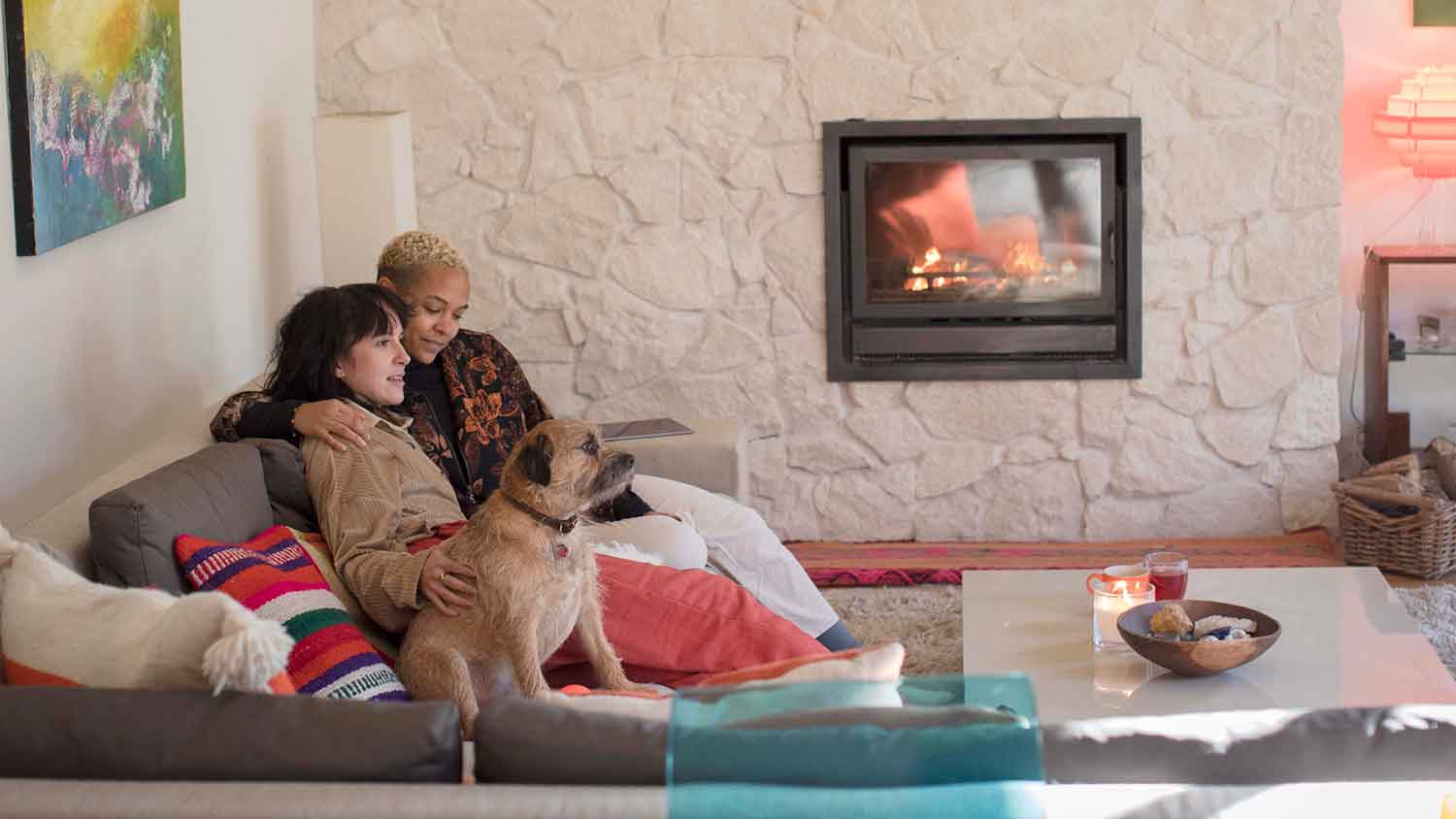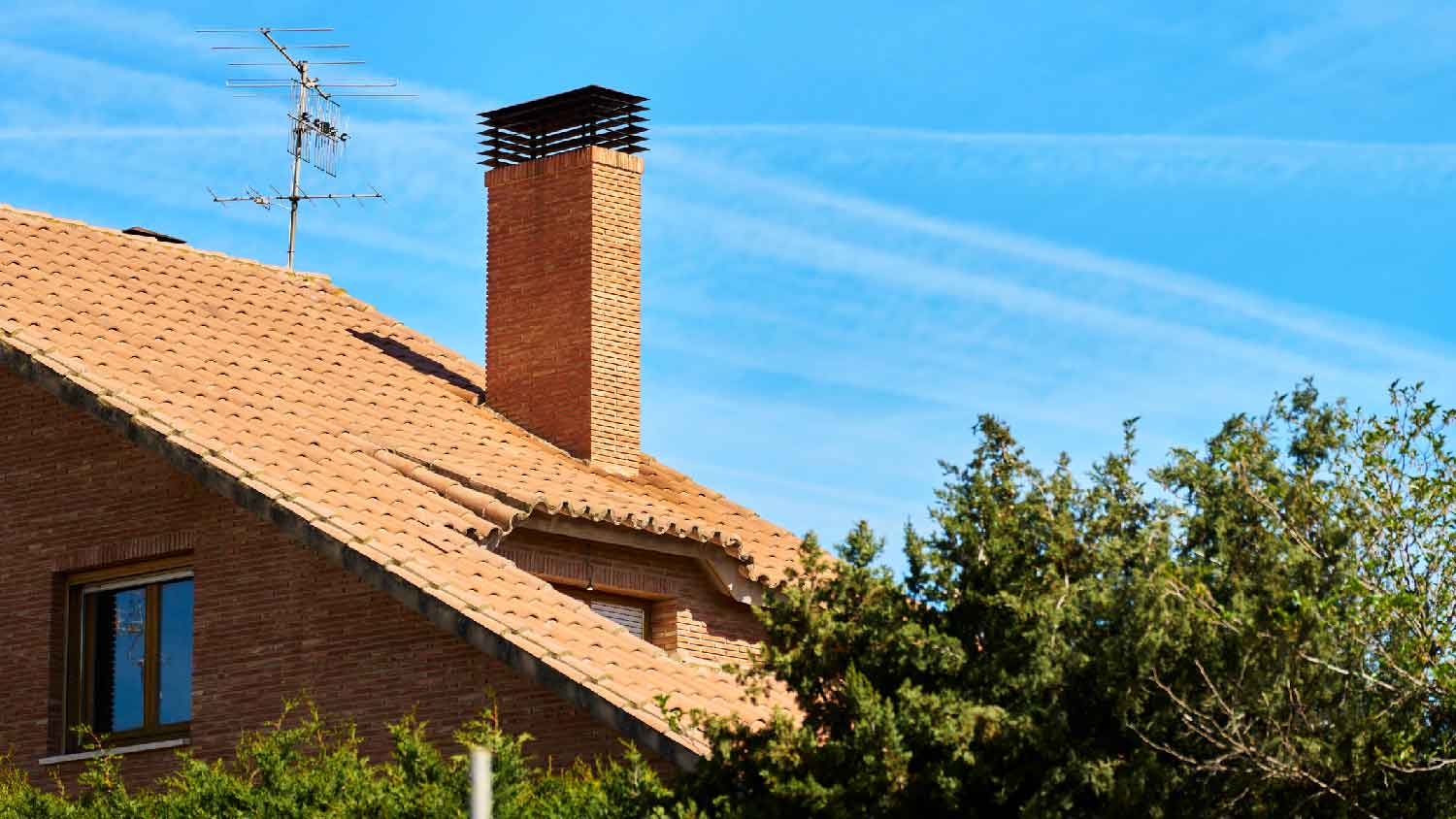
The up-front cost of an electric fireplace is lower than a gas or wood-burning fireplace. This guide will help you understand what you're paying for.
A fireplace makeover delivers transformative results


Spending a cozy night in front of your fireplace is not quite as relaxing when you can’t stop thinking about how your dated fireplace needs a makeover. Learning how to reface a fireplace is a challenging DIY job, but the benefits to this focal point can change the feel of your entire home. If you’re a novice to home improvement projects, or if you want the benefits of a fireplace makeover without the challenges of doing it yourself, there’s nothing wrong with relying on a professional.
Before beginning what some people consider the most enjoyable part of learning how to reface a fireplace—the demolition—be certain about what you want to do. A refacing job may involve tearing out existing stone, brick, and other materials and replacing them. However, if you decide to use stucco or concrete over a brick fireplace, you could cover the existing material without needing demolition.
Either way, the process of refacing a fireplace is a messy job. Tape heavy drop cloths on the floor around the existing fireplace to protect it from damage. If you want extra protection for the floors, use a thin hardboard to absorb impact from the demolition. Make sure you have safety gear on hand, including eye protection and a dust mask. Because of the potential for dust generation, you may want to cover furniture in plastic or hang plastic sheets over entrances to the room.
Start by taking down the current mantel, if your fireplace has one. If you plan to reuse it, you need to be very careful in taking it down. If reusing it, mark its exact location on the wall so you can easily reset it. Some mantels can be quite heavy and awkward, so have a second person available to help you.
You may need to loosen caulk between the mantel and the wall. Use a utility knife to cut through the caulk. Then use a pry bar to work behind the mantel and gently pry it loose. It’s usually easier to work from the underside of the mantel to start prying, as the mantel may be sitting on top of a brace.
If the mantel has support posts, these may need to come down before you can pull the mantel loose.
If you are reusing the same mantel, do not remove the braces. You will need to work around them when refacing the fireplace. If you are installing a new mantel, you can remove all of the brace material.
You don’t have to replace the fireplace hearth when refacing a fireplace. If you are keeping the hearth, skip this step. However, you should use hardboards and a heavy drop cloth to cover and protect the hearth.
Use the demolition hammer and chisel to start chipping the hearth away from the floor. Start at the back with the chisel. The hearth may have a wooden frame with materials over the top of the frame. If you can loosen it from the back, it may pull away from the fireplace in a single piece. Otherwise, break it into pieces to remove it.
If you have a poured concrete hearth, the removal process is far more difficult. If it’s a solid piece, you may have no choice but to use a sledgehammer on it to try to break it away.
If you have tiles along the floor in place as the hearth, use the pry bar or chisel to work underneath the tiles and pop them loose.

The facing could consist of natural stone, stucco, tile, brick, wood, or masonry veneer. With wood, you can just pop it loose with a pry bar. You also may be able to go directly over the wood facing with the new material if the wood is tightly attached, meaning you don’t need to remove it.
If the stucco is in good shape, you often can attach the new materials without needing to remove it, meaning you can skip this step.
If you plan to go over the existing stone, brick, or masonry veneer with stucco or concrete, you can skip this step.
Use your chisel and hammer to strike the mortar around the stones. Move the chisel a few inches and strike it again. Continue moving around the stone until you loosen it enough to remove it. Always use caution that the larger stones don’t pop loose unexpectedly and hit you.
Remove the larger stones this way. Once you have some holes, you may be able to move the chisel inside a hole and begin chipping out the mortar. Hopefully, some of the pieces will start coming out faster in chunks.
Use the chisel and hammer to chip away at the grout between tiles, breaking it loose. Once you have a gap, you can then slide the chisel under the tile and pop it loose.
Otherwise, if you don’t mind breaking the tiles, use your demolition hammer to break the tiles into pieces. Use caution, as the pieces will fly around and can be extremely sharp.
Use the chisel and hammer to break up the mortar between the bricks. Remove as much mortar as possible. Once the bricks are loose, you should be able to pull them away individually.
If you want the process to go faster, you can use a sledgehammer to break the bricks into pieces. Always wear safety gear and eye protection, as the chunks of brick may fly around.
Use the chisel and hammer to try to break up any mortar you can see. If you don’t see mortar, start at an edge of the installation with the chisel or pry bar and break the veneer loose.
Removing the first piece is the hardest part of the job. Once you have one piece out to create a gap, you can insert the chisel or pry bar and remove other pieces easier.
Continue working across the entire layout of the veneer, removing individual pieces until it’s all gone.
After this step, use a vacuum or broom to remove any stray material before continuing. You want to clean up as much of the material and dust as possible before you try to adhere the new facing materials. Use a stiff-bristled brush to go over the entire fireplace structure to pull dust loose.

Before continuing with the steps for how to reface a fireplace, you’ll want to build a new hearth. The materials you are using to reface the fireplace can abut the hearth. If you did not remove the previous hearth, you can skip this step.
Depending on what you are using for the new hearth, you may need to build a wood frame, add tiles, add bricks, or install a slab of concrete.
Whatever you decide to use as your new hearth, make sure it extends far enough away from the fireplace to match your local building codes. The hearth is vital for catching any sparks that fly out of the firebox, and it must consist of a material that will not burn.
If you’re unsure about how to build the new hearth, hiring a local fireplace contractor may be the best choice. You don’t want to make a mistake here that could end up causing a house fire.
Remove any adhesive or mortar that remains on the face of the fireplace. You want to create a space that’s as smooth as possible.
In many cases, installing cement board over the existing fireplace area is a good idea. Cement board often is heat resistant and can easily support the weight of the refacing material you select.
If you’re installing brick, tile, stone, or masonry veneer, use thinset mortar over the cement board or the existing base material. Then attach the new pieces for refacing the fireplace. Use mortar or grout between pieces, as needed, to secure the layout. You probably need to allow everything to dry overnight before taking any further steps, but follow the exact drying instructions for your mortar and grout product.
You may need to cut pieces of veneer or tiles to fit at the edges of the fireplace. Use an angle grinder or a tile saw to make a clean cut.
Continue working upward toward the space for the mantel. If you need to go above the mantel with the new facing material, install the mantel first, and then continue going above it.
If you are installing wood, such as for a DIY shiplap fireplace, you can attach the wood pieces directly to the cement board.
If you are adding stucco or concrete over the existing fireplace, you’ll want to apply a concrete bonding agent to the cement board or to the fireplace facing that you left in place. Then apply the first coat of stucco or concrete. Continue working until it reaches the desired look and a thickness of about 3/8 to 1/2 of an inch.

If you are replacing the original mantel or installing a new mantel that you purchased, leave space for it. As another option, learning how to build a fireplace mantel is a job you can do with a bit of woodworking experience and the right tools, should you prefer to make your own.
If you are working with an existing wood-burning fireplace, you’ll need to locate the wall studs to secure the bracket for the mantel. If there are no wall studs in a masonry fireplace, you can use French cleats to secure the mantel. Use a level to ensure everything is straight. You may need to add some trim work around the mantel.
If you have an electric or gas fireplace, you need to follow the specific instructions for installing a mantel that came with the fireplace. You don’t want to damage any aspects of this type of fireplace.
Learning how to reface a fireplace is a challenging DIY project for a novice. If you have some experience with installing tile and mixing thinset, you’ll have a better chance of a successful DIY job.
For a difficult job like this, that has to be done right to deliver the design benefits you want, there’s nothing wrong with hiring a professional to do the work. Local fireplace remodelers can give you some ideas for the refacing and ensure that the job looks perfect in the end.
When hiring a pro, a fireplace remodel costs, on average, $400 to $2,000. If you want higher-end materials, like stone or stone veneer, you can expect to pay a price above the upper end of the average range. Covering the existing material with concrete or stucco is a cheaper option.
Professionals can do the job faster than the average homeowner, so your fireplace will be ready to use faster. But if you have a desire to tackle a tough job, it can be quite satisfying to complete a refaced fireplace yourself over a couple of days.
From average costs to expert advice, get all the answers you need to get your job done.

The up-front cost of an electric fireplace is lower than a gas or wood-burning fireplace. This guide will help you understand what you're paying for.

Before installing a gas fireplace insert, it’s important to understand the various cost factors. Here’s how much an average gas fireplace insert costs.

The firebox handles the brunt of the work in your fireplace. If your firebox is wearing down, check out the average costs of repairs and replacements.

There are four fireplace types: wood-burning, gas, electric, and ethanol. The right one for your home depends on your desired aesthetic and level of upkeep.

So your fireplace stinks—what’s the deal? Find out the six potential reasons why your fireplace smells and how to fix them.

If you have a wood-burning fireplace, it’s important to understand what causes chimney fires so you can reduce the risk of a fire in your home.